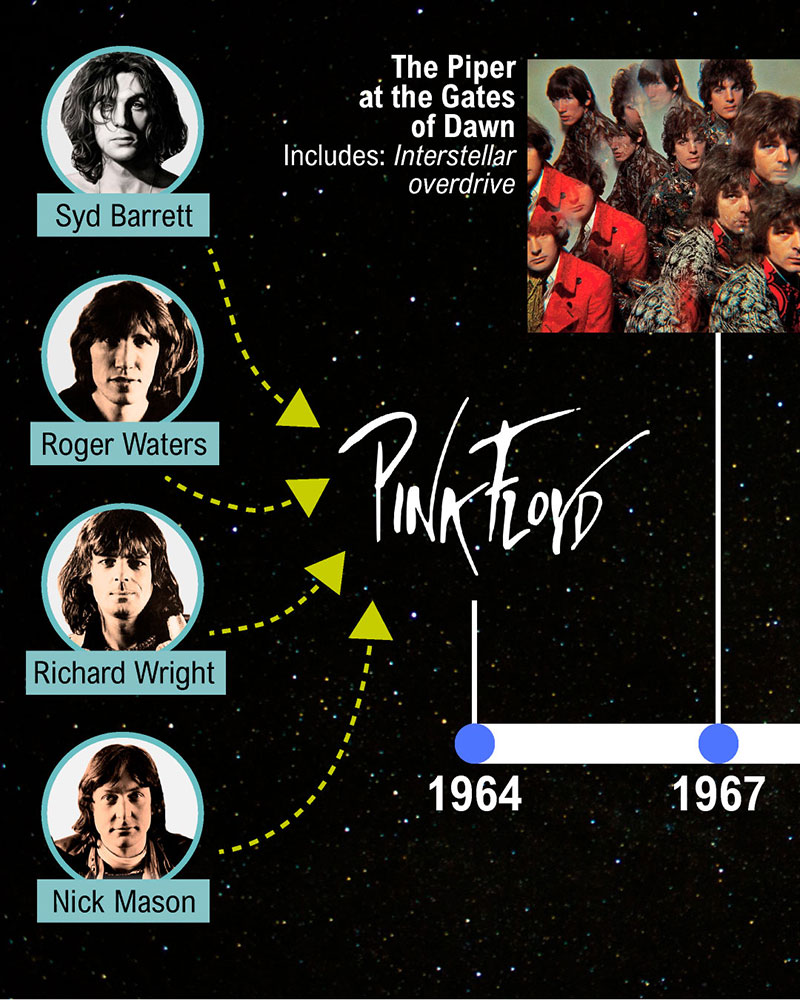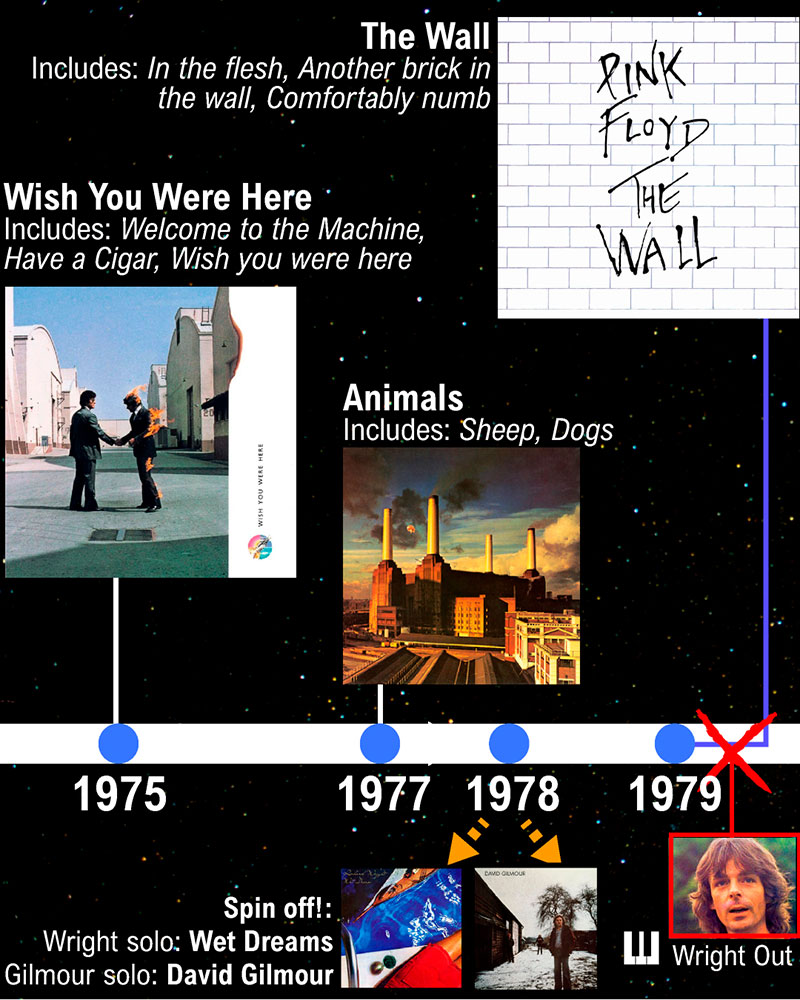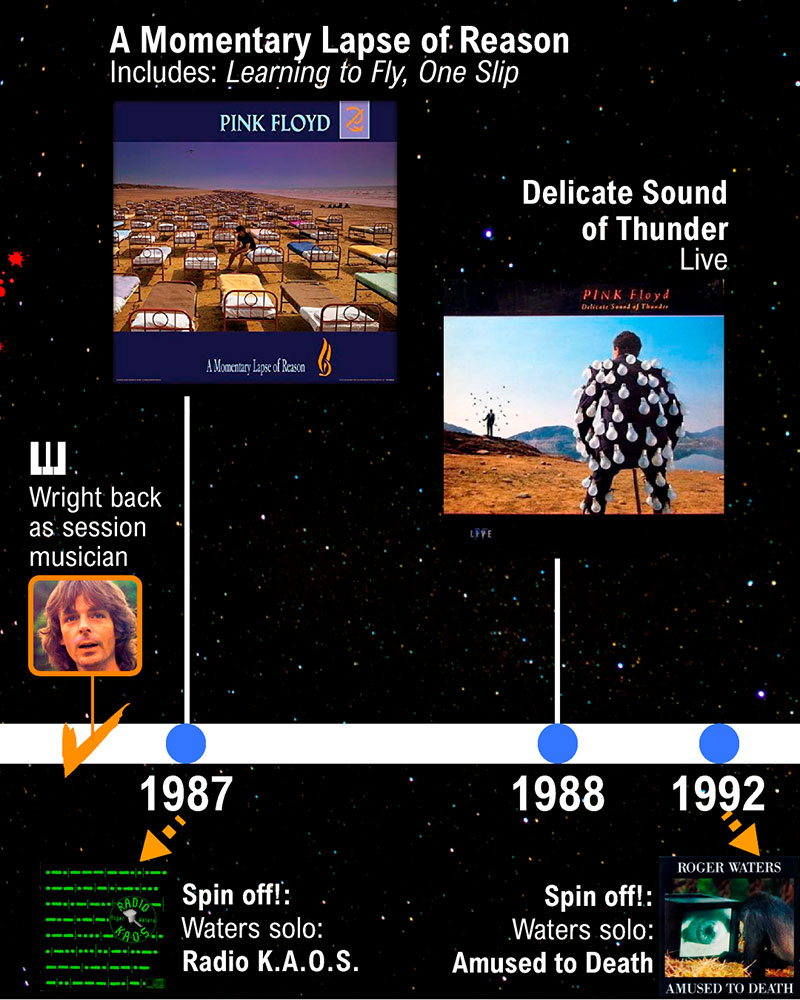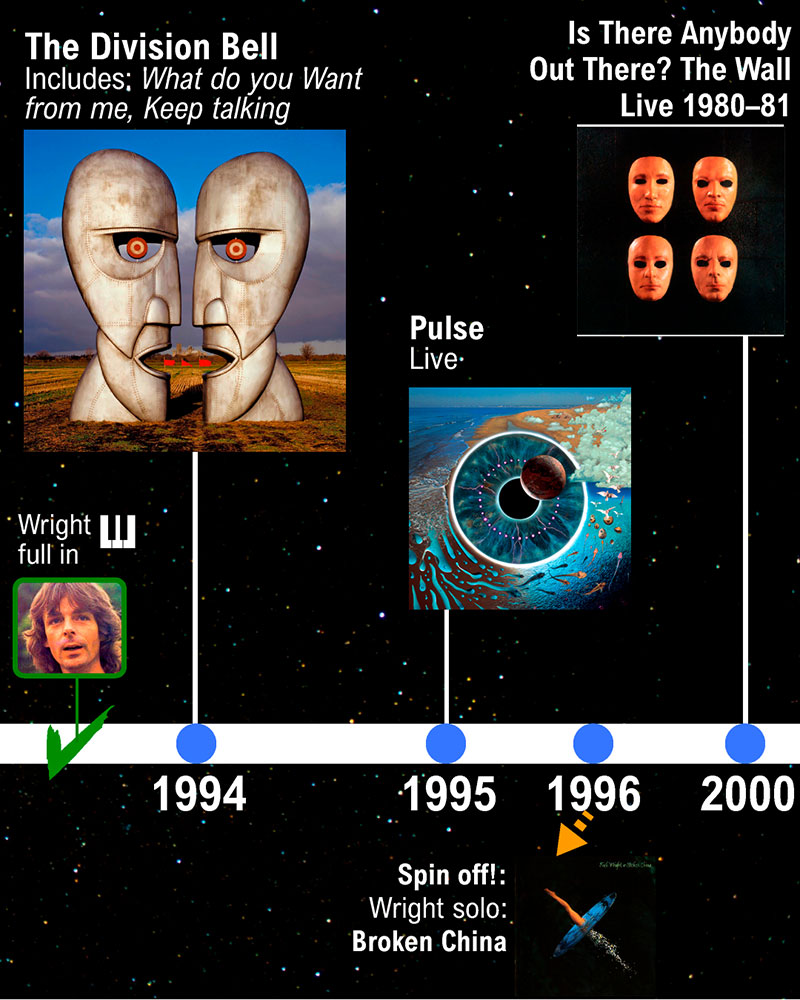In this post, we will go through the history of Pink Floyd in a graphic timeline. Check out chronological details about Roger Waters’ and David Gilmour’s banda right below:
Pink Floyd’s history summarized
1964 – 1967: Beginnings with Syd Barrett
The band was formed in 1964 in England by Syd Barrett (guitar, vocals), Roger Waters (bass, vocals), Richard Wright (keyboard), and Nick Mason (drums). Led by Barrett, they began as a psychedelic and experimental rock band.
As it is widely known, Syd Barrett’s behavior was really problematic, marked by mental illness and drug abuse. It was nearly impossible for the band to perform and rehearse with him, which lead to conflicts on the tour to promote Pink Floyd’s first album, The Piper at the Gates of Dawn (1967).
1968 – 1972: Barrett out, Gilmour joins
Before starting the recording of their second album, A Saucerful of Secrets (1968), guitarist David Gilmour became a member of the band. Also, Barrett was fired from the band due to his worsening mental problems and drug abuse.
In subsequent albums such as More (1969), Atom Heart Mother (1970), Meddle (1971), and Obscured by Clouds (1972), Pink Floyd maintained their psychedelic approach to their songs as well as collective songwriting dynamic.
1973 – 1979: Pink Floyd’s mainstream success era
In 1973 Pink Floyd reached one of the peaks of their career when they released the critically acclaimed album The Dark Side of the Moon. The LP included well-known classics like Breathe, Money, and The Great Gig in the Sky. This album established them as an iconic band for progressive and experimental rock. The Dark Side of The Moon was a concept album that addressed human issues such as death, materialism, and the meaning of life.
As a side note here, we have covered the influences of Pink Floyd´s The Dark Side of the Moon in another post.
The albums that immediately followed The Dark Side of The Moon are also considered Pink Floyd classics. 1975’s Wish You Were Here was conceived partly as a tribute to their former bandmate Syd Barrett, while 1977’s Animals was another concept album with a clear political-ideological approach. By this time Roger Waters had already established himself as the chief songwriter and mastermind of the band.
In 1979 Pink Floyd again found massive success. Their album The Wall was released as a double-format rock opera, which was inspired by Syd Barrett, and also fascism and social isolation. It was during the recording of this album that keyboardist Richard Wright was urged by Roger Waters to leave the band.
1983 – 1985: Pink Floyd’s crisis & Waters’ departure
With Waters in full control over Pink Floyd, in 1983 the band released a sequel to The Wall: The Final Cut. The album contains notable references to the Falklands war between Argentina and England, naming English minister Margaret Thatcher and the de facto military president of Argentina, Leopoldo Galtieri.
In 1985, Roger Waters left Pink Floyd. Roger’s idea was that the band would cease to exist, but David Gilmour and Nick Mason decided to continue. That led to a legal battle between the two parties, which was initially settled in the mid-1980s. As a result of that settlement, Gilmour, Mason could perform as Pink Floyd and with Roger Waters retained the rights to the famous album The Wall.
In 1987, without Wright as an official member but still participating as a session musician, Pink Floyd released A Momentary Lapse of Reason. Usually, it is considered one of the band’s least appealing albums.
1994 – 2014: The end of Pink Floyd
In 1994 Pink Floyd release what is considered “the real deal” in their “Gilmour era”: the critically acclaimed The Division Bell.
The last time that Roger Waters, David Gilmour, Richard Wright, and Nick Mason performed live together as Pink Floyd was on July 2, 2005, during Live 8. After this, the main members of Pink Floyd would never reunite on the same stage again.
Syd Barrett passed away on July 7, 2006.
On September 15, 2008, Richard Wright passed away.
In 2014, the album The Endless River was released by the two remaining members of Pink Floyd, David Gilmour and Nick Mason. The album was completed using takes recorded by Wright before his death, making it the final studio album of the band.
Pink Floyd’s discography
Pink Floyd has released fourteen studio albums.
- 1967: The Piper at the Gates of Dawn
- 1968: A Saucerful of secrets
- 1969: Music from the Film More
- 1969: Ummagumma
- 1970: Atom Heart Mother
- 1971: Meddle
- 1972: Obscured by Clouds
- 1973: The Dark Side of the Moon
- 1975: Wish You Were Here
- 1977: Animals
- 1979: The Wall
- 1983: The Final Cut
- 1987: A Momentary Lapse of Reason
- 1994. The Division Bell
- 2014. The Endless River











